Ornamentation between art and nature on display in Reggio Emilia with works by great artists
The long history ofOrnament between art and nature will be the protagonist of the exhibition entitled What a wonderful world. The Long History of Ornament between Art and Nature, open to the public from November 16, 2019 to March 8, 2020 at Palazzo Magnani and the Cloisters of San Pietro in Reggio Emilia.
Through more than two hundred works, from private collections and national and international museums, such as the Victoria&Albert Museum in London, the Hermitage Museum in St. Petersburg, the Muséand du quai Branly in Paris, the Uffizi Galleries in Florence, the Museum of Modern and Contemporary Art in Trento and Rovereto, the Peggy Guggenheim Collection in Venice, and the National Gallery of Modern Art in Rome, the many facets of ornamental art will be traced, to understand how decoration andornament play an important role in the world.
The works on display, spanning from the Roman era to the present, were created by great artists such as Albrecht Dürer, Leonardo da Vinci, Giovan Battista Piranesi, Alphonse Mucha, Maurits Corneils Escher, Pablo Picasso, Henri Matisse, Giacomo Balla, Gino Severini, Josef and Anni Albers, Andy Warhol, Keith Haring and many others.
Divided into several sections, the exhibition aims to investigate the origins and developments of the link between everyday life, art, and Decoration, and to address in detail the experiences of much twentieth-century and new-millennium art in which the themes of Ornament were brought back into play.
The first section focuses on the natural world to analyze how plants and animals ornament themselves by changing their outward appearance.
The second will analyze the human practice of adorning one’s body, through clothing and accessories, such as earrings, necklaces, and jewelry.
The section devoted toArs Canusina, invented and conducted by Reggio Emilia psychiatrist Maria Bertolani Del Rio (1892-1978), within the San Lazzaro asylum in Reggio Emilia and developed in the first half of the 20th century, will be particular.
It will follow the evolution of the ornamental plant motif through the centuries and across cultures: from Attic vases to Romanesque capitals, to William Morris’ 19th-century translations, to which is added the weave motif; moving away from a naturalistic vision and taking its cue from the same craft practices related to goldsmithing and textile production, the Middle Ages favored the meticulous description of tangles, intricate weaves, knots. Visitors will be enveloped in the hypnotic knot patterns of the plutei from Bobbio Abbey (9th century) and engravings from drawings by Albrecht Dürer and Leonardo da Vinci.
The exhibition will continue with a series of rooms that will contextualize and illustrate the current vision of ornament, which was perfected between the 19th and 20th centuries. From the second half of the twentieth century until today, there has been a revival of ornamental forms. Indeed, Ornament has crept into even such a seemingly averse figurative culture as that of many artistic avant-gardes between the early twentieth century and after World War II.
An in-depth study in the field of music will conclude the exhibition.
The exhibition is promoted by the Palazzo Magnani Foundation, in collaboration with the Municipality of Reggio Emilia, the Province of Reggio Emilia, the Emilia Romagna Region and the Ministry of Cultural Heritage and Activities and is curated by Claudio Franzoni and Pierluca Nardoni.
For info: www.palazzomagnani.it
Hours: Tuesday through Friday from 10 a.m. to 1 p.m. and 3 p.m. to 7 p.m.; Saturday and holidays from 10 a.m. to 7 p.m.
Tickets: Full 12 euros, reduced 10 euros, 6 euros for children 6 to 18 years old. Free for children under 6.
Image: Keith Haring, Untitled (Egypt) (1982; acrylic on paper, 100 x 130 cm; Milan, Consolandi Collection) © Roberto Marossi
 |
| Ornamentation between art and nature on display in Reggio Emilia with works by great artists |
Warning: the translation into English of the original Italian article was created using automatic tools. We undertake to review all articles, but we do not guarantee the total absence of inaccuracies in the translation due to the program. You can find the original by clicking on the ITA button. If you find any mistake,please contact us.





























